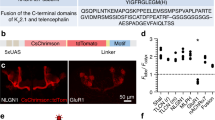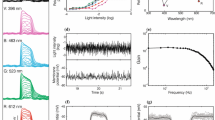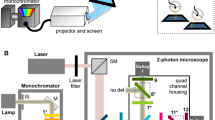Summary
Light quanta impinging upon the photopigments located in the rhabdomeric receptor structures of the fly's compound eyes trigger photochemical reactions which in turn elicit miniature receptor potentials (bumps). The paper mainly deals with the problem whether a single quantum of light is sufficient, or whether a coincidence of quanta and/or elementary photochemical events is necessary to trigger a miniature receptor potential.
The experiments were based on tests of the optomotor responses of fixed flying flies suspended in a rotating patterned cylinder with periodic distributions of inner surface brightness. The tests were made under two different light programs: 1) Illumination constant in time 2) Illumination by periodic light pulse sequences with various frequencies. Average light fluxes absorbed by the receptors were equal in both programs. Theoretical considerations lead to the following conclusions: The strength of the optomotor responses to the light programs 1 and 2 should not differ from each other in the case of single quantum processes. However for multiquantum processes light program 2 should be more effective than light program 1 as it favours the coincidence of quantum absorptions per unit time. But these theoretical conclusions are valid only if two conditions are fulfilled in the experiments: a) The pulse frequency of light program 2 has to be kept below a certain limit which is determined by the kinetics of the photochemical systems. Otherwise light program 2 gets averaged in time and in principle can be not more effective than light program 1. b) The rates of quanta absorbed by the receptors have to be kept low enough to guarantee that the concentration of unbleached pigment molecules remains practically unchanged as compared with the concentration in darkness. Accordingly the test experiments were carried out with light pulse frequencies ranging from 500 to 1/120 cycles per second. Intensities were used which corresponded to an average quantum flux effective for one rhabdomeric structure ranging between 10 and 250 quanta per second.
The interpretation of the experimental results is in accordance with the hypothesis that one single quantum of light is sufficient to trigger an elementary photochemical reaction and that in turn one single photochemical event can elicit a miniature receptor potential. At present time the experiments do not allow conclusions about the possible occurrence of coincidence-functions of synapses at the level of the first optical ganglion which receive their information via fibers leading off from the receptors.
In one of the appendices of the paper, the transinformation flux into a receptor is calculated, taking into consideration the Poisson noise of the quanta disrupting the signal at extremely low quantum rates.
Similar content being viewed by others
Literatur
Braitenberg, V.: Patterns of projection in the visual system of the fly. I. Retina-lamina projections. Exp. Brain Res. 3, 271–298 (1967).
Dietrich, W.: Die Fazettenaugen der Dipteren. Z. wiss. Zool. 92, 465–539 (1909).
Fermi, G., u. W. Reichardt: Optomotorische Reaktionen der Fliege Musca domestica. Kybernetik 2, 15–28 (1963).
Fourtes, M. G. F., and S. Yeandle: Probability of occurrence of discrete potential waves in the eye of Limulus. J. gen. Physiol. 47, 443–463 (1964).
Götz, K. G.: Optomotorische Untersuchung des visuellen Systems einiger Augenmutanten der Fruchtfliege Drosophila. Kybernetik 2, 77–92 (1964).
Hecht, S., S. Shlaer, and M. H. Pirenne: Energy, quanta and vision. J. gen. Physiol. 25, 819–840 (1942).
Kirschfeld, K.: Discrete and graded receptor potentials in the compound eye of the fly (Musca). Proc. Int. Symp. on The Functional Organization of the Compound Eye, p. 291–307. Oxford and New York: Perrgamon Press 1966;
— Die Projektion der optischen Umwelt auf das Raster der Rhabdomere im Komplexauge von Musca. Exp. Brain Res. 3, 248–270 (1967).
Kirschfeld, K., u. N. Franceschini: Optische Eigenschaften der Ommatiden im Komplexauge von Musca. Kybernetik (1968a) (im Druck);
Kirschfeld, K. Ein Mechanismus zurRegelung des Lichtflusses in den Rhabdomeren des Komplexauges von Musca. Kybernetik (1968b) (in Vorbereitung).
Langer, H.: Grundlagen der Wahrnehmung von Wellenlänge und Schwingungsebene des Lichtes. Verh. dtsch. zool. Ges. Göttingen 30, 195–233 (1966).
MacNichol, E. F.: Sub-threshold excitatory processes in the eye of limulus. Exp. Cell Res. 5, 411–425 (1958).
Reichardt, W.: Quantumsensitivity of light receptors in the compound of the fly musca. Cold Spr. Harb. Symp. quant. Biol. 30, 505–515 (1965);
— Detection of single quanta by the compound eye of the fly musca. Proc. Int. Symp. on The Functional Organization of the Compound Eye, p. 267–289. Oxford and New York: Pergamon Press 1966.
Reichardt, W., u. D. Varjú: Übertragungseigenschaften im Auswertesystem für das Bewegungssehen. Z. Naturforsch. 14b, 674–689 (1959).
Rice, S. O.: Mathematical analysis of random noise. In: Selected papers on noise and stochastic processes, ed. by N. Wax, p. 133–294. New York: Dover Publ. Inc. 1954.
Rushton, W. A. H.: Flash photolysis in human cones. Photochem. and Photobiol. 3, 561–577 (1964).
Scholes, J. H.: Discrete subthreshold potentials from the dimly lit insect eye. Nature (Lond.) 202, 572–573 (1964);
Scholes, J. H. The quantal content of optomotor stimuli and the electrical responses of receptors in the compound eye of the fly musca. Kybernetik (1968) (in Vorbereitung).
Trujillo-Cenoz, O.: Some aspects of the structural organization of the intermediate retina of dipterans. J. Ultrastruct. Res. 13, 1–33 (1965).
Varjú, D., u. W. Reichardt: Übertragungseigenschaften im Auswertesystem für das Bewegungssehen II. Z. Naturforsch. 22b, 1343–1351 (1967).
Yeandle, S.:, Ph. D. Thesis, Johns Hopkins University 1957;
Yeandle, S. Electrophysiology of the visual system — Discussion. Amer. J. Ophthal. 46, 82–87 (1958).
Author information
Authors and Affiliations
Additional information
Ein Teil der in dieser Arbeit abgedruckten Ergebnisse wurde bereits in zwei vorläufigen Mitteilungen publiziert, Reichardt (1965, 1966).
Rights and permissions
About this article
Cite this article
Reichardt, W., Braitenberg, V. & Weidel, G. Auslösung von Elementarprozessen durch einzelne Lichtquanten im Fliegenauge. Kybernetik 5, 148–169 (1968). https://doi.org/10.1007/BF00271248
Received:
Issue Date:
DOI: https://doi.org/10.1007/BF00271248




